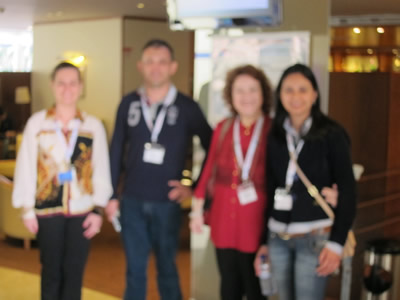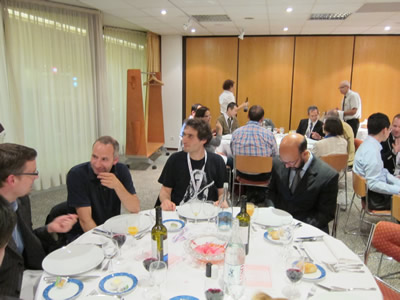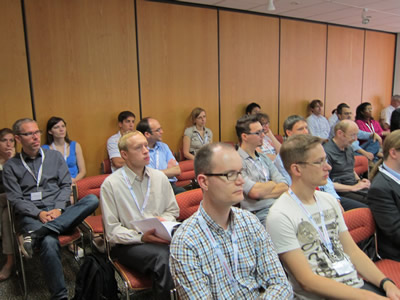ACHI 2022 - The Fifteenth International Conference on Advances in Computer-Human Interactions
June 26, 2022 - June 30, 2022
ACHI 2022
Onsite and Online Options: In order to accommodate a large number of situations, we are offering the option for either physical presence or virtual participation (pdf slides or pre-recorded videos).
ISSN: 2308-4138
ISBN: 978-1-61208-982-9
ACHI 2022 is colocated with the following events as part of DigitalWorld 2022 Congress:
- ICDS 2022, The Sixteenth International Conference on Digital Society
- ACHI 2022, The Fifteenth International Conference on Advances in Computer-Human Interactions
- GEOProcessing 2022, The Fourteenth International Conference on Advanced Geographic Information Systems, Applications, and Services
- eTELEMED 2022, The Fourteenth International Conference on eHealth, Telemedicine, and Social Medicine
- eLmL 2022, The Fourteenth International Conference on Mobile, Hybrid, and On-line Learning
- eKNOW 2022, The Fourteenth International Conference on Information, Process, and Knowledge Management
- ALLSENSORS 2022, The Seventh International Conference on Advances in Sensors, Actuators, Metering and Sensing
- SMART ACCESSIBILITY 2022, The Seventh International Conference on Universal Accessibility in the Internet of Things and Smart Environments
ACHI 2022 Steering Committee
|
 |
Flaminia Luccio
University Ca' Foscari of Venice
Italy
|
|
 |
Lasse Berntzen
University of South-Eastern Norway
Norway
|
|
 |
Marie Sjölinder
RISE
Sweden
|
|
 |
Weizhi Meng
Technical University of Denmark
Denmark
|
ACHI 2022 conference tracks:
INTER: Interfaces
Graphical user interfaces; Intelligent user interfaces; Adaptive user interfaces; Multi-modal user interfaces; Context-based interfaces; Virtual reality and 3D interfaces; Speech and natural language interfaces; Interfaces for collaborative systems; Interfaces for restricted environments; Internationalization and reflections of culture on interface design; Interfaces for disadvantaged users; Interface specification and design; Interface prototyping; Interface testing; Interface evaluation; Interface generators and other tools for developing interfaces; Data visualization; Visualization techniques; Interactive visualization
SUSTAIN-CHI: CHI and sustainability
What is the scope of sustainable HCI research presently? How does sustainable CHI align with global sustainability challenges? How could CHI research and practice support overcoming societal barriers to positive environmental changes? How does CHI relate to circular economies and life cycle thinking? What methods and methodologies support sustainable CHI research? How can CHI challenge unsustainable everyday practices? How can CHI support building sustainable cultures? How can CHI help develop sustainable behaviors among children and youth?
HUM-IND4.0: Human-centered industrial technologies
Human-centered process optimization and systems integration; Human-centered chains; Human-centered risk management and nano-technology; Human-centered automation processes and technologies; Human-in-the-middle for micro and nano technology simulations; Industry chains and human-robot and human-agents interaction; Micro and nano technology-oriented human challenges; Human-oriented manufacturing processes; Human aspects for reliable process chains; Risk management on nano-particles/interaction with human beings; Human-skills and nano-technologies (e.g., additive manufacturing); Industry 4.0 human-oriented challenges
OUI: Organic user interfaces
Interface-oriented materials and devices; Physical and digital representation; Sensing and display technologies; Rollable and foldable displays with tactile properties; Skin-based input; Analog input interaction design; Flexible display technologies; Functional-based display forms; Flexible-computing and curve computer interactions; 3D continuous display interfaces
HAPTIC: Haptic interfaces
Fundamental of haptic interactions; Tangible user interfaces; Bidirectional information flow ; Haptography; Haptic feedback and control; Bodyware (embedded sensors; flexible structures, associative memories, actuation and power systems); Magnetic levitation haptic interfaces; Kinetic motion-based interaction; Kinetic motion and haptic design; Mindware (learning, adaptation, head-hand coordination, bimanual coordination; discovering affordance, interaction and imitation); Language of motion / Gesture annotation; Interfaces with kinetic properties; Sensor actuator design, development and evaluation; Linear haptic display; Fingertip haptic display; Pen based force display; High bandwidth force display; Quality of experience model for haptic interactions; Haptics rendering;
SYSTEMS: Interactive systems
Highly interactive systems; Intelligent agents and systems; Adaptive systems; Context-aware systems; Multi-user multi-interface systems; Collaborative systems; Computer-supported cooperative work; Distributed information spaces; Communicators and advisory systems; Interaction through wireless communication networks
DEVICES: Interaction devices
General input and output devices; Virtual reality input and output devices; Interaction devices for immersive environments; Shareable devices and services; Mobile devices and services; Pervasive devices and services; Small displays; Very large displays; Tangible user interfaces; Wearable computing; Interaction devices for disadvantaged users; Interaction devices for computer games
DESIGN & EVAL: Interaction & interface design & evaluation
Interface metaphors; Interaction styles; Interaction paradigms; Requirements specification methods and tools; Analysis methods and tools; Design methods and tools; Evaluation paradigms; Evaluation methods and tools; Evaluation frameworks; Scenarios; Task analysis; Conceptual design; Physical design; Information architecture; Information design for websites; Guidelines and heuristics; Experience design; Environmental design; Ethnography; Contextual design; Service design;
MODELS: Principles, theories, and models
Cognitive models; Conceptual models; Mental models; Frameworks for cognition; Model-based design of interactive systems; Formal methods in human-computer interaction
USER: User modeling and user focus
Usability and user experience goals; User testing; User modeling; User profiling; Predictive models (e.g., for user delay prediction); Human perceptible thresholds; User support systems; Psychological foundations for designing interactive system; Human information processing; Digital human modeling; Engineering psychology; Ergonomics; Hearing and haptics; Affective computing
CHILDREN: Children-computer interaction
Using interface-oriented technology toys; Psychological basis for children interfaces; Children interfacing thinking; Smart interfaces for autistic children; Interactive application for Children with Mixed Abilities; Mining children behaviors; Interaction with children with visual impairments; Kids haptic, wearable, tangible learning; Kids vocal interfaces; Immersive gameplay interfaces; Speech loudness interfaces; Children cognitive interfacing skills; Conveying children emotions; Deformable interfaces for children; Incentivizing children crowdsourcing activities; Children and destructive games; Children and interacting fictions; Children and biotic game; Children participatory design; Children and visual design; Children emotional perception; Object-oriented drawing at young age; Children-powered access paradigms and technologies; Children social interaction experiences; Children online gaming behavior; Children and wearable devices; Children-oriented design interaction shortcuts; Teens health self-care; Self-care technologies
ELDERLY: Designing for an aging population
Smart environments for elders; Rethinking mobile interfaces for older users; Motion-based video games in care home settings; Interacting assistive approaches for elders; Detecting elderly emotion; Human-machine interaction for disabled users; Adult opportunistic device interactions; Elderly social interaction; Degrading skills adaptation for elderly interfaces; Robots collaboration for elderly emergency; Unmanned systems for elderly: Applications of ecological interface design
PARADIGMS: Traditional and emerging paradigms
Interaction paradigms; Mobile computing; Wearable computing; Location-aware computing; Context-aware computing; Ubiquitous computing; Pervasive computing; Transparent computing; Attentive environments; Virtual reality; Augmented reality and tangible bits; Immersive environments; Human-based computation; Visual languages and environments; End-user programming; Hypermedia advances and applications; New visions of human-computer interaction
ACCESS: Usability and universal accessibility
Interaction and interface design for people with disabilities; Interaction and interface design for the young and the elderly; Universal access and usability; Usability engineering; Usability testing and evaluation; Usability and internationalization
HUMANWEB: Human-Web Interaction
Natural language interfaces; Keyword-based query interfaces; Hybrid query interfaces; Emotional behavior; Adaptive Web interfaces; Learning User Profiles; Personalized Interfaces; Remembrance Agents; Interaction visualization; Social and psychological challenges
HUM-ROBOTS: Human-robot interaction
Fundamentals of human-robot cooperation; Cognitive models of human-robot interaction; Adaptable autonomy and knowledge exchange; Autonomy and trust; Awareness and monitoring of humans; Task allocation and coordination; Human guided robot learning; User evaluations of robot performance; Metrics for human-robot interaction; Long-term interaction robotics; Health and personal care robotics; Social Robotics; Multi-modal human-robot communication; Robot intermediaries; Experiments and applications
HUM- AGENTS: Agents and human interaction
Principles of agent-to-human interaction; Models for human-agent interaction; Social persuasion in human-agent interaction; Designing for human-agent interaction; Socially intelligent agents and the human in the loop; Agents for human-human interaction; Agent-based human-computer-interaction; Human cooperation and agent-based interaction; Human interaction with autonomous agents Agent-based human-robot interaction; Human and artificial agents emotional interaction
SOCIAL: Social aspects of human-computer interaction
Societal implications of human-computer interactions; Social computing and software Online communities Weblogs and other community building tools Online support for discovery and creativity; Tool support for discovery and innovation Expressive and attentive interfaces and environments Affective aspects of human-computer interaction Emotional design
GAMES: Computer games and gaming
Computer game technology; Computer game engineering; Foundations of computer game design and development; Development processes and supporting tools; Management aspects of computer game development; Architectures and frameworks for computer games; Game-based training and simulation; Serious games; Multi-user games; Online games; Online gaming; Game theories; Audio, video and text in digital games; New computer games and case studies; Performance improvements in computer games; Social impact of games and gaming
EDUCATION: Human-computer interaction in education and training
Interactive systems for education and training; Online and communications support for education and training; Interfaces, interactions and systems for distance education; Software tools for courseware development and delivery; Collaborative systems for teaching, studying and learning; Handheld mobile devices for education and training; Advisory and recommendation systems Techniques and tools for information localization, retrieval & storage; Web annotation systems; Case studies and applications
MED APPS: Applications in medicine
Interactive systems for medical applications; Interactive systems for telemedicine; Interactive systems for telehealth; Interactive systems for telepathology; Interactive systems for telecardiology; Interactive systems for telesurgery; Interactive personal medical devices; Digital imagery and visualization frameworks; Role of colors and color imaging in medicine; Multidimensional projections with application to medicine; Data mining and image retrieval techniques for medical applications; Imaging interfaces and navigation; Internet imaging localization, retrieval and archiving; Video techniques for medical images; Internet support for remote medicine; Computer-controlled communications for medical applications; Medical informatics; Software and devices for patient monitoring; Interactive software for therapy and recovery
TELECONF: Teleconferencing
Fundamentals for teleconferencing; Platforms for teleconferencing; Devices for teleconferencing; Videoconferencing, Web Conferencing; Performance in teleconference applications; Real-time aspects in teleconferencing; Privacy and security in teleconference applications; QoS/SLA for teleconferencing applications; Teleconferencing services; Business models for teleconferencing
APPLICATIONS: Other domain applications
Interactive interfaces and systems for scientific applications; Interactive interfaces and systems for engineering applications; Interactive interfaces and systems for business applications; Interactive interfaces and systems for activities in arts & humanities; Interactive interfaces and systems for scientific research; Other applications of interactive interfaces and systems
Deadlines:
Submission | Mar 26, 2022 |
Notification | Apr 22, 2022 |
Registration | May 06, 2022 |
Camera ready | May 10, 2022 |
Deadlines differ for special tracks. Please consult the conference home page for special tracks Call for Papers (if any).











































